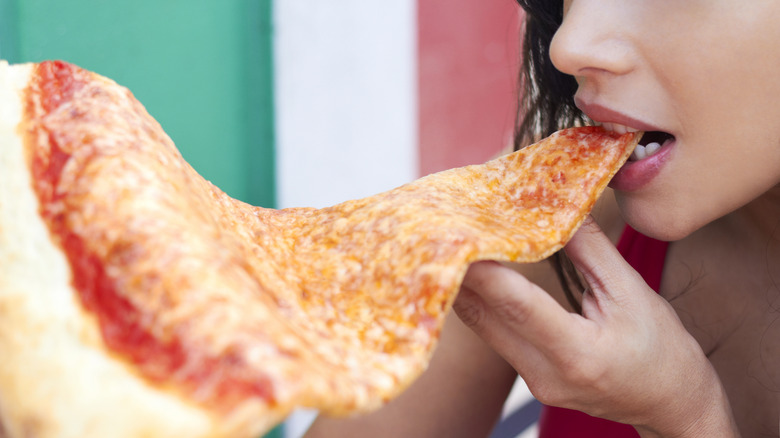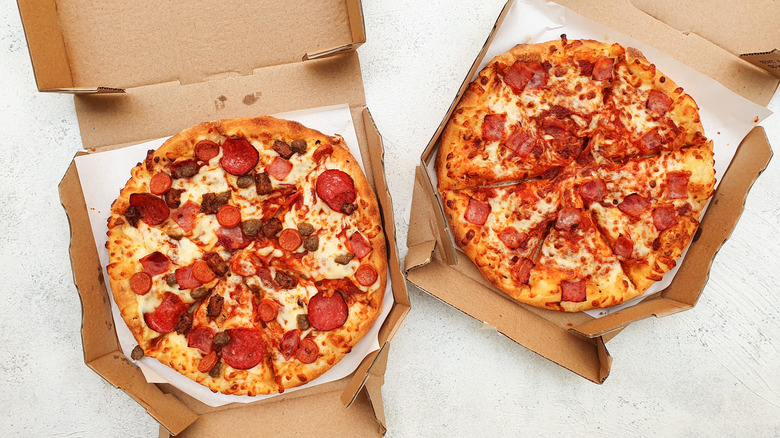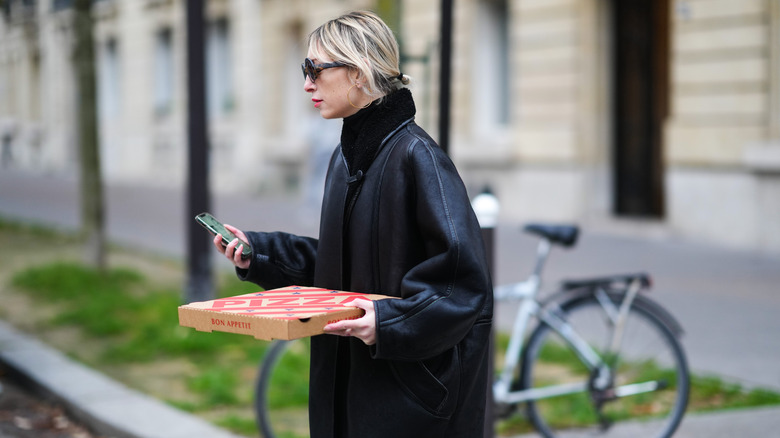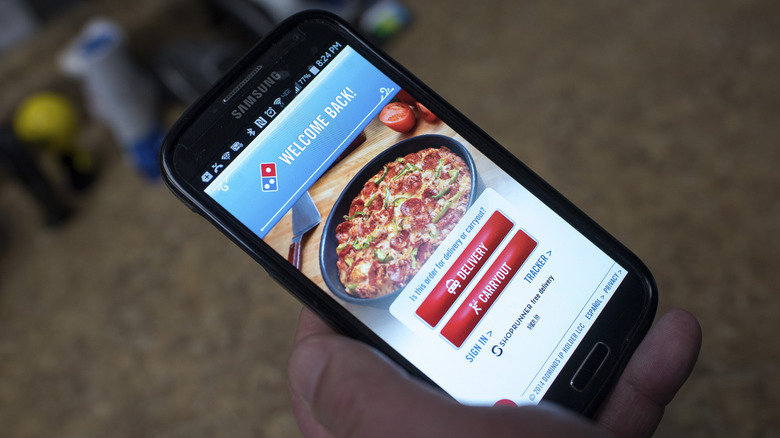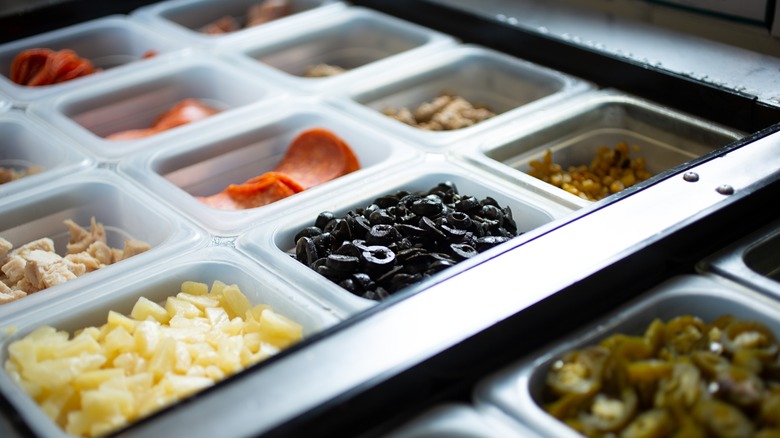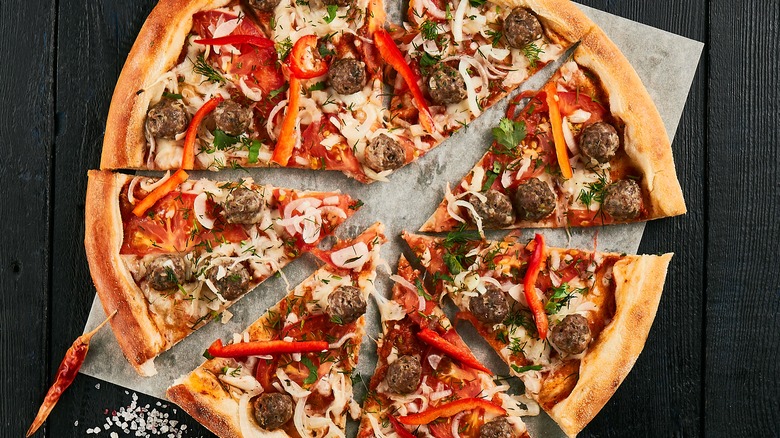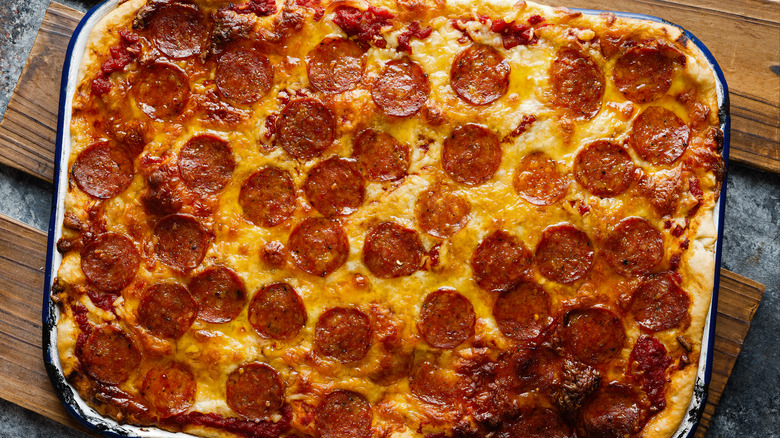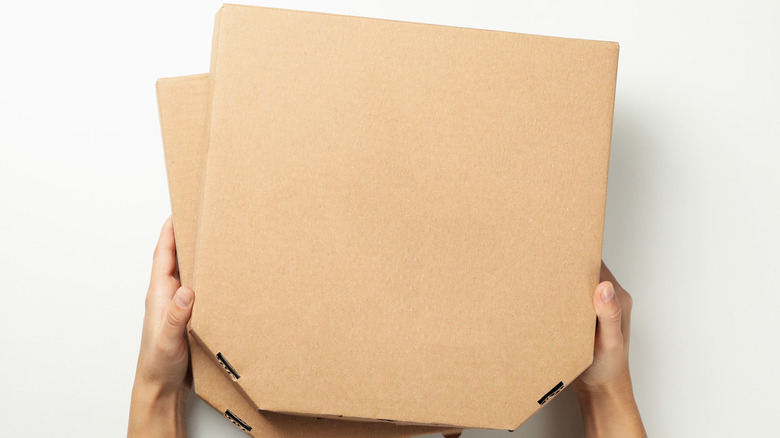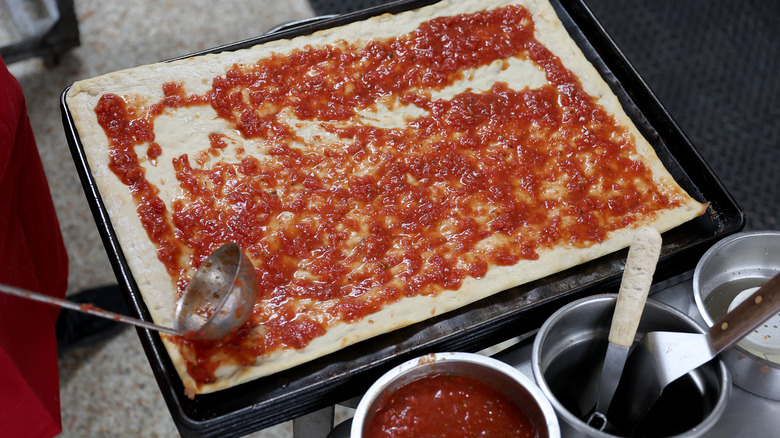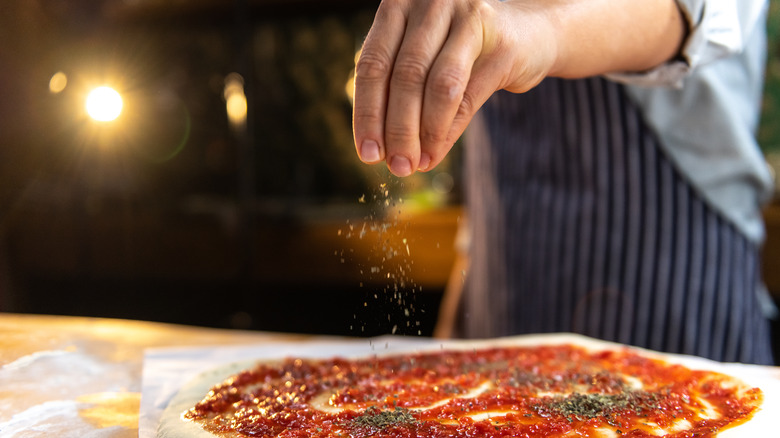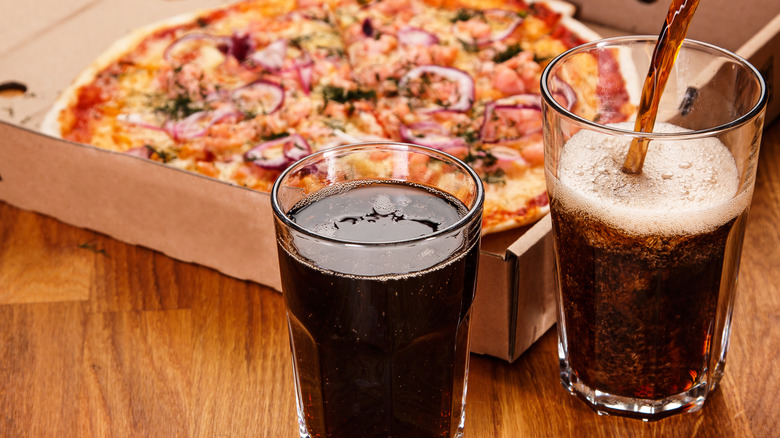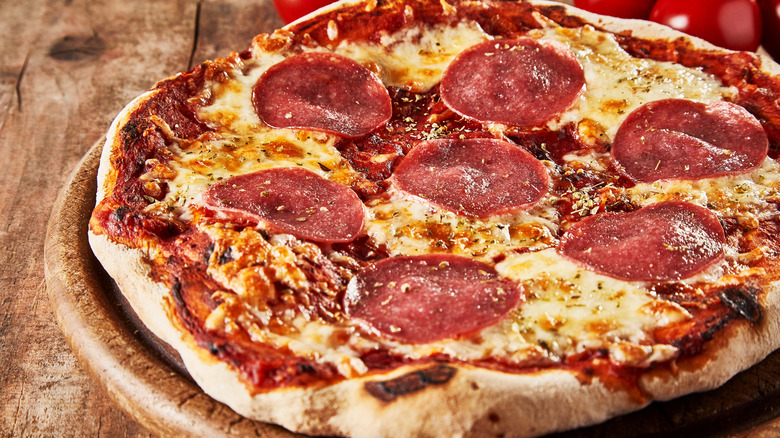14 Pizza Ordering Hacks You'll Wish You Knew Sooner
It's no secret that Americans are head over heels for pizza. Per a 2014 report, the USDA estimates 13% of Americans eat pizza on a given day — and 22% of people ages 6 to 19. Statista says there were more than 75,000 pizza restaurants in the U.S. in 2021 generating sales of over $45 billion. Although both numbers are down slightly from 2020, that's still a lot of dough.
We know it's easy to fall into a routine with food. The Guardian points out one British survey where 77% of adults reported that, for the past nine months, they'd eaten the same thing for lunch every day. There are some advantages to eating the same meal over and over, such as portion control and budgeting. But if you're eating more than 6,000 slices of pizza in your life, like New York Daily News reports, then you might be ready for a little variety.
By knowing a few pizza ordering tips and tricks, you can move beyond the familiar — and maybe save some money. Plus, when there's suddenly a crowd to feed, knowing what and how to order will help things go just right. With these pizza ordering hacks, you can view and eat pizza in a whole new way.
Get larger pizzas instead of smaller ones
If you want to get the most pizza for your money, the best way is to size up. People love getting a great deal. According to The Food Institute, a whopping 77% of people use coupons when they go to restaurants. But even if there isn't a special at your pizza joint of choice, you can usually still save by going with the large pizza.
As AsapScience explains, although pizza places give the diameter as measurement, the area is the truly relevant size — and this increases much faster than the diameter. In their example, a 16-inch diameter pizza gives you the same amount of food as four 8-inch pizzas. If the 16-inch pizzas are $18 each and the 8-inch pies are $9 each, it's easy to see what the better bargain is.
So when in doubt, go with the philosophy of "bigger is better" and enjoy a pizza encore the night after. Don't want to do a lot of math yourself? Omni Calculator has an online tool to compare pizza sizes and prices so you know if you're getting the best deal.
Use math to order enough pizza for everyone
When you're ordering pizza for a crowd, getting the right amount can be a challenge. If you don't order enough, people go hungry; too much will have you paying extra and saddle you with leftovers. A few extra slices are nice, of course, but considering the USDA says most leftovers are only good for 3 to 4 days, you don't want to go overboard.
So how do you get the order just right? Pizza places such as Salerno's Pizza recommend the 3/8 rule. This states the average adult will eat three of the eight slices on a typical large pizza. So for 10 adults, you should order four large pizzas. Always round up to make sure you have enough. For kids, two slices per meal should be perfect.
Also, if you're not able to ask in advance what toppings people want, fear not. YouGov has conducted a national survey about America's most and least popular pizza toppings. So going with pepperoni, sausage, and extra cheese is usually a safe bet. Conversely, you may want to steer clear of unpopular or controversial toppings like anchovies, eggplant, and pineapple.
Join rewards programs
Nearly every major restaurant, and even a lot of smaller local spots, have a rewards or loyalty program. As Altametrics observes, these can work in different ways. Most often, you either earn points for spending a certain amount or a free item after visiting a certain number of times. Regardless, the concept is the same: You get discounts and bonuses for ordering the pizza you love.
It's not just customers that benefit from these programs, either. Accenture reports that loyalty program members produce up to 18% more revenue for a business than non-members. Menufy says a big reason for this is the program helps customers feel wanted and appreciated, which keeps them coming back more so than a one-off coupon.
So make yourself part of this win-win by joining the rewards program at your favorite pizza joint. Many places offer more than just points and periodic freebies. For example, Pizza Hut has member-only deals and allows you to save orders, delivery addresses, and payment methods so you can get your pie faster. Some programs also do personalized offers. It's an easy way to save on delicious pizza.
Order extra pizza and freeze the rest
You don't need to have a big group or an enormous appetite to take advantage of a great deal. Many pizza restaurants offer "meal deals" and other specials, including money-off discounts, buy-one-get-one promotions, and event-based deals (via LinkedIn). Although these are typically aimed at large parties, one or two people can still get a deal without throwing away a bunch of uneaten pizza.
The solution is simple: Freeze the leftovers for later. The USDA says leftovers remain good for up to four months in the freezer. Technically, the leftover pizza can be frozen forever, although the flavor will start to deteriorate beyond this point. While some are more conservative in their estimates — WikiHow recommends up to two months in the freezer — that's still plenty of time to get your pizza fix.
It's easy to freeze leftover pizza, too. Just place the slices in aluminum foil, plastic wrap, a freezer bag, or a plastic container labeled with the date. When you feel like pizza, let it thaw in the refrigerator for a few hours, then bake for 5 minutes at 350 degrees to enjoy that day-you-ordered taste.
Get carryout instead of delivery
Delivery versus carrying out is one of the great pizza debates. Based on data from Statista, delivery is more popular, with American consumers spending $19.8 billion on pizza delivery in 2021 compared to $17.5 billion on takeout. It's easy to understand why — they bring the pizza right to your door and you don't even have to put shoes on.
But we're here to tell you carryout has many advantages. To begin with, Food Tech Digest notes delivery times are often at the whims of traffic and drivers. One wrong turn can mean cold pizza. If the restaurant is short on staff, it will take even longer for your food to arrive. Choosing the pickup option when you order also lets you skip the line — and you can order from literally anywhere.
Finally, as CNBC details, "ordering in adds up fast." Restaurants and third-party platforms add fees to delivery orders, which can mean paying more than an extra 10% per meal. You're also expected to tip the driver, increasing your cost further. If you get food delivered several times a week, you're likely getting three meals for the price of four. Picking the order up yourself means you get cheaper pizza faster.
Order ahead, especially for large parties and holidays
It's understandable why you would want to order pizza for a big group or event. After all, it's tasty, and you don't have to cook. But remember: If you have the urge for pizza, chances are a lot of others do, too. The American Pizza Community estimates 12.5 million pizzas are sold on Super Bowl Sunday alone — and that's not even the most popular pizza day, with the Orlando Sentinel reporting that Halloween ranks higher.
These busy days and big orders require a lot of restaurant resources. TableTime notes that placing an order even a couple of hours ahead gives them time to plan. They'll be able to dedicate the proper staff or call in extra hands. And, as Dreamz Canaria adds, the pizza place is less likely to run out of supplies if they know what's needed beforehand.
Many pizza joints now allow you to order days in advance. For instance, at Papa John's, you can order 21 days ahead if you're paying with cash. Future orders can often be placed even when the restaurant is closed. So grab the phone or fire up the app and make sure your pizza is ready when you want it.
Add a few custom toppings
It's easy to limit yourself to the pizza toppings a restaurant offers. And to be fair, some of them have a lot, such as the dozens of toppings typically available at Domino's. However, a few of your own can take a pie to the next level. As Men's Health points out, home toppings are usually both fresher and healthier. Experts go back and forth on whether pizza is healthy (via CNN). But the toppings play a big role, so if you want to enjoy pizza while getting the right nutrients, fresh home toppings are a great option.
There are many ways to upgrade your pizza. America's Test Kitchen suggests everything from extra cheese to caramelized onions. You also can try out toppings not typically found at restaurants such as eggs. Give the pizza a quick reheat in the oven to keep your crust crispy and enjoy your custom creation.
As a bonus, this hack is cheaper than getting extra toppings from the pizza place. A 2017 Forbes article estimates the average restaurant pays 48 cents for a meat pizza topping while charging you $3 — a 525% markup. That's reason enough to just order a base cheese pizza and let your imagination run wild.
Don't overload the toppings
Some people think the more toppings, the merrier. If you can afford it, why not order all the things you love? But pizza makers and scientists alike have pointed out there's a limit on what a pie can handle. Pizza maker Derrick Tung even tells The Takeout that going overboard is the single biggest blunder when it comes to pizza toppings.
Why is this? Three Big Bites notes too many toppings can muddle the flavors and hurt the overall taste. More importantly, NA-Pizza says excessive toppings ruin how the pie cooks. They block the oven's heat from getting to the crust, add moisture, and can be too heavy for the crust to support. An overly-topped pizza will either end up a soggy mess or burned to a crisp.
There's a hidden reason not to go all-out on toppings, too. A former Domino's employee claims that, if you order more than four toppings, they add less of each one (via Joe). While this prevents the messy result we discussed above, it also means you're getting a worse deal. Overall, 2-5 toppings is generally recommended as the sweet spot for taste, texture, and value.
Get your pizza well done
Well-done food is often associated with overcooked and bland. Just ask steak eaters — according to FiveThirtyEight and Longhorn Steakhouse data, only 11.7% of people order their steak well done. Even late chef Anthony Bourdain was known to hold a particular disdain for it (via Kitchen Confidential: Adventures in the Culinary Underbelly).
However, in the case of pizza, a few extra minutes in the oven can be a good thing. Philadelphia magazine expounds that "it's the secret to turning everyday pizza into great pizza." Cooking pizza well done helps make both the toppings and crust crispier while browning the cheese. Brooklyn Craft Pizza adds that the toppings set better so they don't fall off when you take a bite. To bring steak back into this, Mama Cucina compares well-done pizza to searing a steak so it has a nice outer crust.
Some pizzerias, including Domino's, allow you to order a pizza cooked well done (via Twitter). If your favorite restaurant doesn't, simply preheat the oven to between 400 and 500 degrees, add your takeout or delivery pizza, and cook until it has a golden brown crust and bubbly cheese. We think you'll find it very impressive indeed.
Use the pizza box as plates
Who needs to get out plates when you can make your own? If you don't feel like cooking, you probably don't feel like washing dishes either. Others share the sentiment: In a study by Kelton Global and Birds Eye, 43% of respondents in multi-person households admitted to arguing about the dishes (via Cision PR Newswire).
But you don't even need paper plates to enjoy your pizza. Some people know about the Chinese food hack to convert a to-go box into a plate (via WikiHow). You can do something similar with a pizza box. As detailed by The Sun, remove the box lid, fold it into quarters, then tear along the lines to create a quartet of disposable or recyclable plates. In some cases, you can remove the edge from the bottom and fold it into a smaller box for leftovers.
At least one manufacturer even does the hard work for you. GreenBox has patented a pizza box with perforated lines on the lid that make it easy to separate into four sections (via Packaging World). Some restaurants have created customized versions, so check around and see if it's available near you.
Experiment with different sauces
Though many people focus on the toppings, cheese, or crust, the sauce is the true "secret ingredient" of pizza. According to PMQ, the sauce produces 41% of pizza's flavor. Doreen's Pizzeria calls it the most important part of the pie, saying it provides the base flavor profile and ties the rest of the pizza together.
So if you're looking for a change of pace, consider trying a new sauce. Tomato-based red sauces are the traditional style, believed to have first been used around the year 1735 (via Pizza), but there are many others to consider. The chefs at 575 Pizzeria note "white pizza" often uses olive oil, garlic oil, alfredo, or ranch-based sauce. You also can use pesto, barbecue sauce, and ginger sauce. Even classic tomato sauce has countless flavors based on the other ingredients.
The next time you order pizza, take a look at the sauce offerings. Even the national chains have plenty of choices — Domino's alone offers five different base sauces. Some restaurants allow you to order extra sauce or go light. Another option is to get sauces drizzled over the pizza or dipping sauces for some pop.
Add some more seasoning
Another way to get more zing from your pizza is to use herbs, spices, and other seasonings. They've been added to food and drink going back centuries both for flavor and health benefits (via Journal of AOAC International). Chances are you've already experienced the taste and aroma of good pizza seasoning — eHow notes that additives like basil and oregano are what give this dish its recognizable flavor.
Using more of these herbs or a variety of other seasonings can give your palate a new experience. SliceLife recommends dried oregano to enhance traditional toppings, garlic powder for "sharp and sweet," crushed red pepper to bring the heat, and chopped parsley for a sophisticated fresh taste. Tom "The Dough Doctor" Lehmann and Cane Rosso chef Lee Hunzinger tell PMQ that additions like salt, rosemary, cayenne pepper, and even dill can also pair well.
Some pizza joints like Papa John's let you add certain seasonings to your order for a small fee. If they don't, or you want to try something else, keep the spice rack stocked at home and sprinkle some on yourself. To get the full effect, give the pizza a quick reheat before eating, as studies have shown hotter temperatures make many spices feel more potent.
Get the drinks at the grocery store
It's admittedly convenient to grab a bottle of soda, iced tea, or another beverage from the same place you got your pizza. However, your wallet won't be happy. According to Business Insider, restaurant soda and sugary beverages have one of the biggest markups in the food industry, averaging a mind-boggling 1,150%. That's a higher percentage than restaurant wine, domestic beer, and movie theater popcorn.
To put this in perspective, another Business Insider article from 2017 estimated the average price to make a 12-ounce can of soda is 16 cents. A 1,150% markup means the same can would cost you $2 at a restaurant. A 2-liter bottle's worth of soda (67.6 ounces) at that rate would be $11.27. No wonder they give free refills!
So if you're craving a soft drink with your pie, make a second stop at the grocery store for a bottle or some cans. As of October 2022, the Federal Reserve Bank of St. Louis placed the average retail cost for 2-liters of soda at a relatively paltry $2.25. Or just stick to tap water — since it's calorie-free, you'll have more room for that yummy pizza.
Order your pizza uncut
Want to enjoy pizza even more without changing a single ingredient? The best pizza hack is the easiest: order the pizza uncut. It might seem cheesy at first, but there are a few good reasons to do this. For starters, Inizio Pizza Napoletana explains that by cutting the pizza before it gets to you, the crust takes on moisture from the sauce and toppings. This vastly changes the taste and texture of a pizza's foundation.
Lifehacker adds that restaurants usually cut the pizza when it's too hot for the cheese and toppings to have set. This makes both more likely to fall off when you grab a slice. Also, if you plan to reheat your pizza, it's a lot easier to put in the oven if it hasn't been cut yet.
Italian chef Pierpaolo Pittia tells Eater Las Vegas that, in his home country, the pie is never sliced before serving. So ask for your pizza to be uncut, get a cool pizza cutter or knife, and join a fine tradition. As a bonus, you can cut slices into whatever size and shape you want — including the "perfectly fair way" discovered by two British mathematicians and described by CNET.

